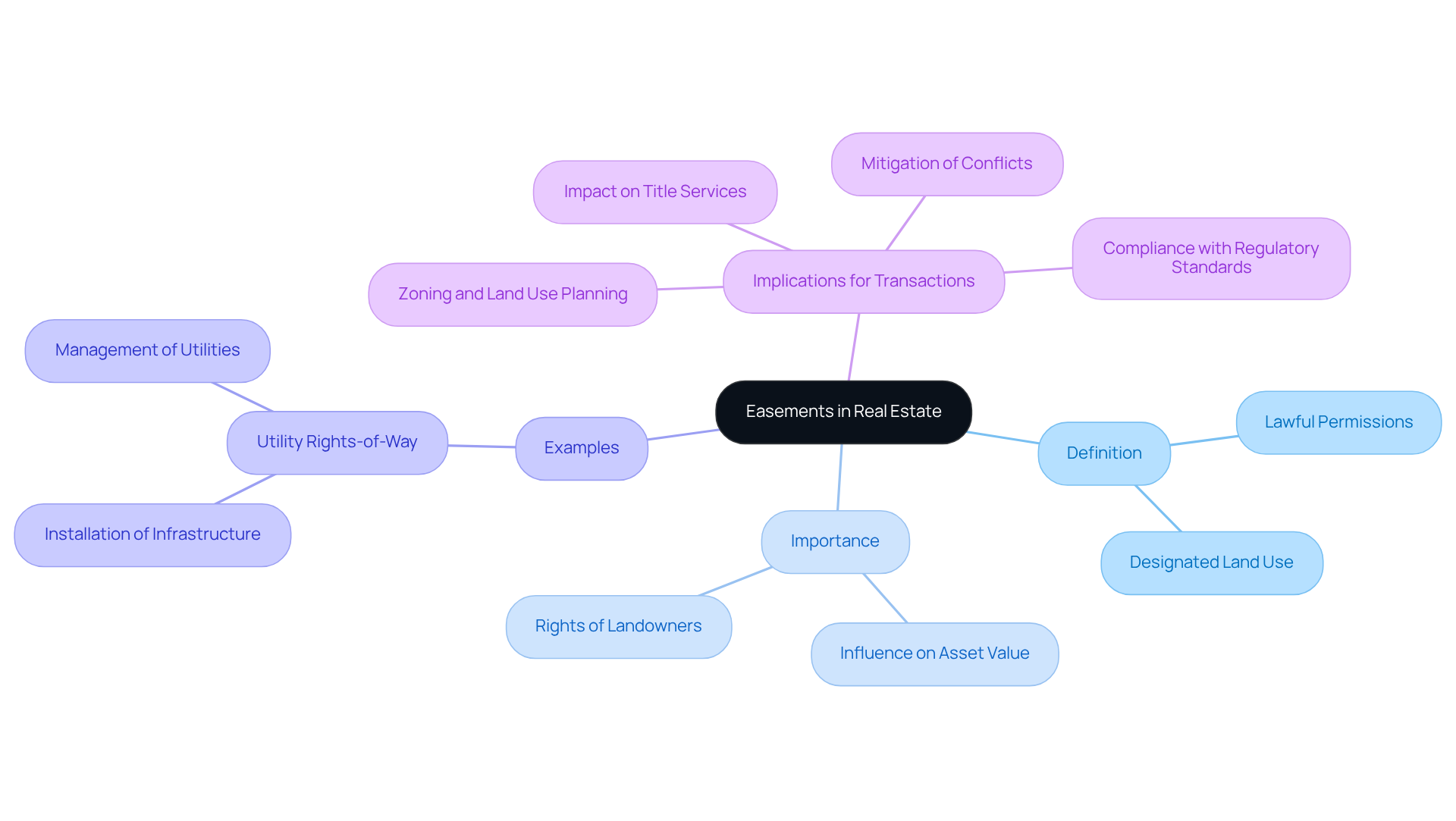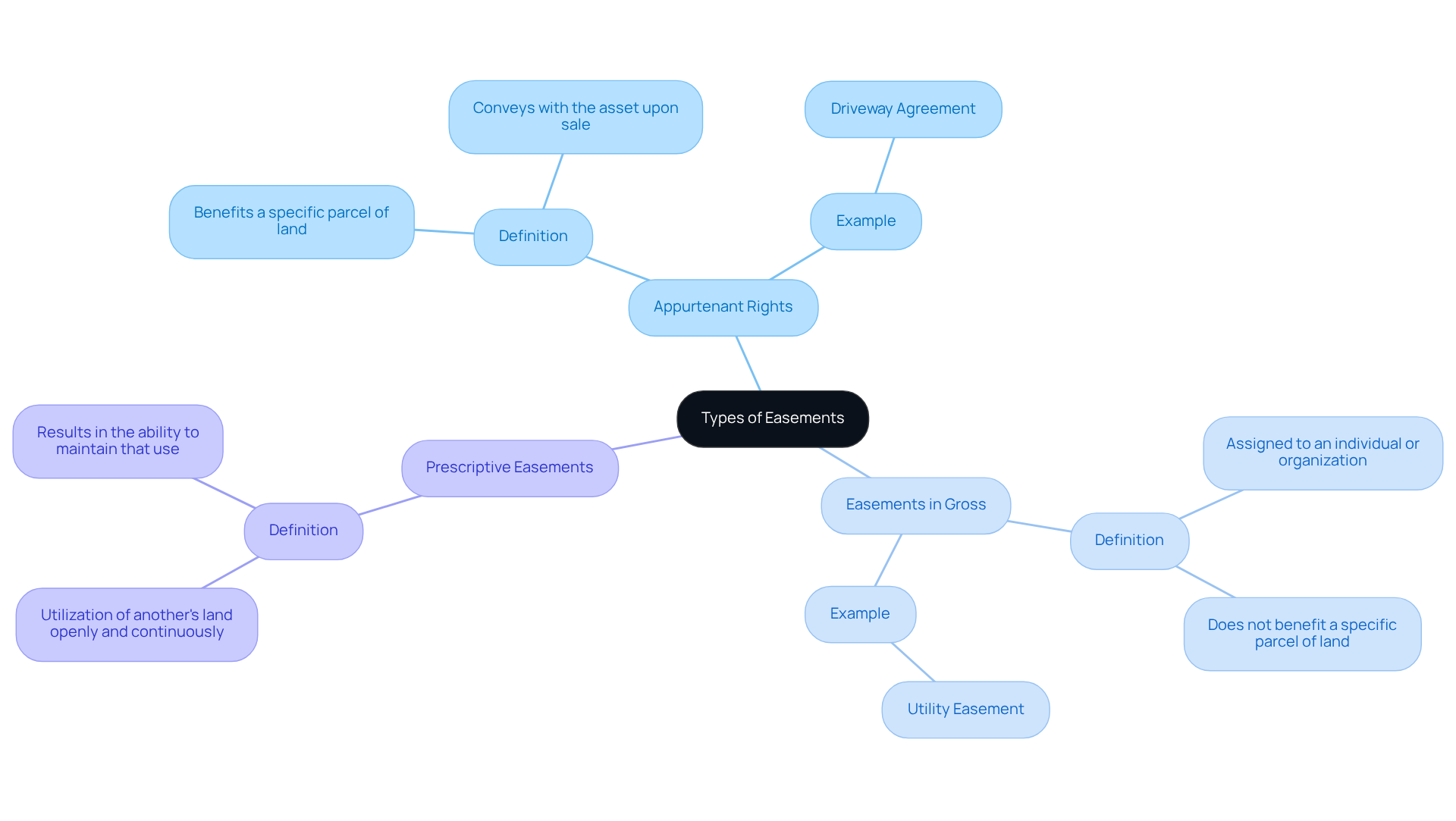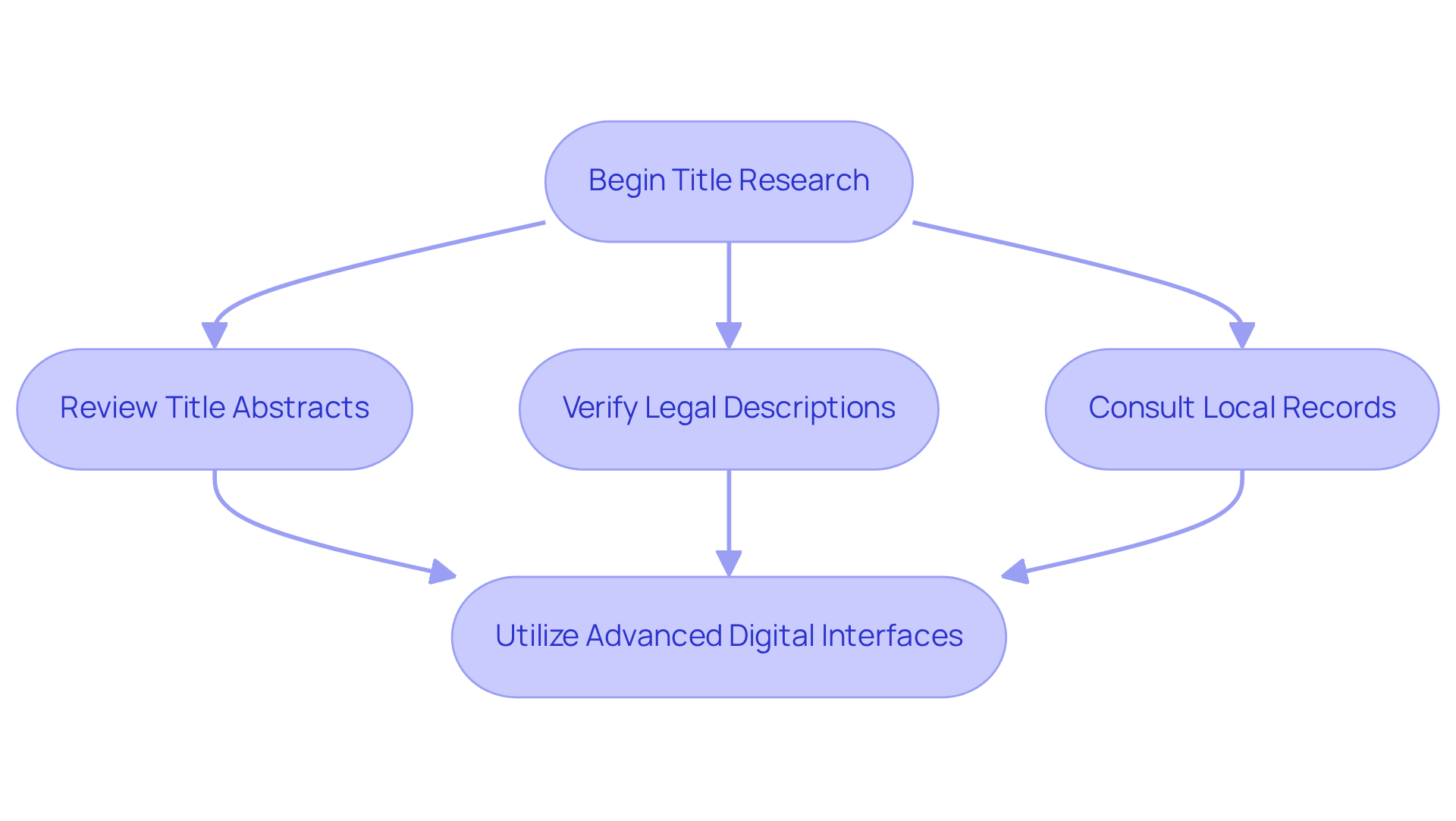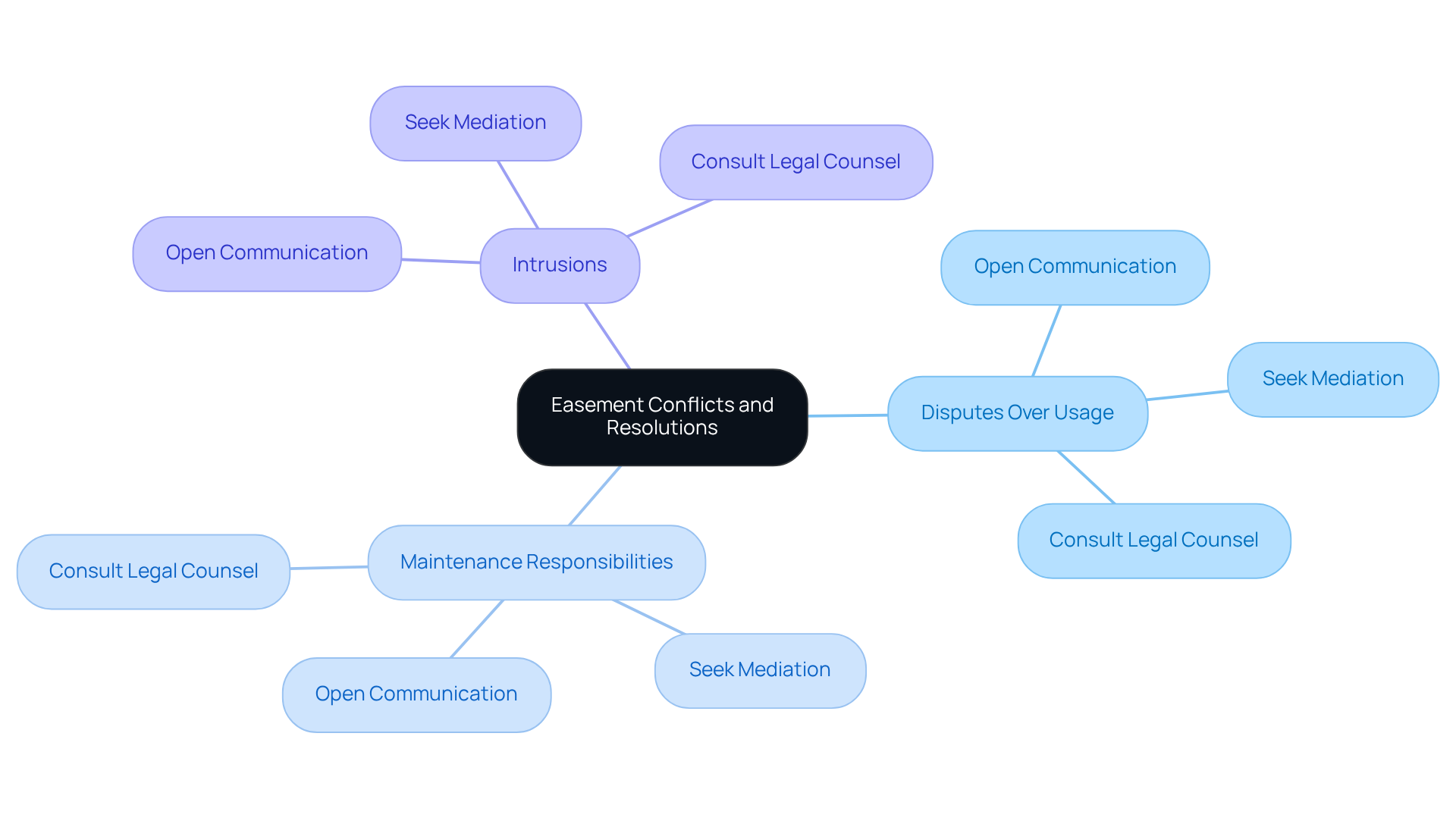Overview
Easements represent legal permissions that enable individuals or organizations to utilize a portion of another's land for specific purposes, playing a pivotal role in real estate. They significantly influence land use, property value, and owner rights. Understanding the management of easements within title services is essential, as it equips title researchers to accurately document rights of way.
Furthermore, this knowledge aids in resolving potential disputes and ensuring compliance with legal standards. Consequently, it protects the interests of landowners and maintains clear property titles.
Introduction
Easements are pivotal in the intricate landscape of real estate, conferring specific rights to utilize segments of land owned by others. Their influence on property values and the rights of landowners is substantial, underscoring the necessity for real estate professionals and title researchers to comprehend their complexities.
As legal frameworks evolve and new forms of easements arise, stakeholders must navigate the potential conflicts and implications these rights introduce to property transactions. Grasping the nuances of easements in title services is essential for unlocking the full potential of real estate dealings while steering clear of costly disputes.
Define Easements and Their Importance in Real Estate
Easements represent lawful permissions that empower individuals or organizations to utilize a designated section of another's land for specific purposes. Their significance in real estate cannot be overstated, as they dictate land usage, thereby influencing asset value and the rights of landowners.
For instance, a utility right-of-way grants utility companies the authority to install and manage essential infrastructure, such as power lines or water pipes, on private property.
Understanding how easements are handled in is paramount for title researchers and real estate professionals, as this knowledge can significantly impact real estate transactions, zoning, and land use planning.
Furthermore, accurately identifying and documenting rights of way ensures compliance with regulatory standards and mitigates potential conflicts between landowners and right holders.

Explore Different Types of Easements and Their Legal Implications
Easements can be categorized into several types, each carrying distinct legal implications.
- Appurtenant Rights benefit a specific parcel of land, referred to as the dominant estate, and are inherently connected to the land. These rights convey with the asset upon sale. For instance, a driveway agreement may provide access to a landlocked parcel, ensuring that the owner can reach their land without obstruction.
- Easements in Gross, in contrast, do not benefit a specific parcel of land but are assigned to an individual or organization. A typical instance is a utility easement, which permits power companies to install and maintain infrastructure across private land.
- Prescriptive Easements occur when an individual utilizes another's land openly and continuously for a legally defined duration, ultimately resulting in the ability to maintain that use. Understanding how easements are is crucial for title researchers, as they must precisely evaluate ownership interests and mitigate potential disputes.
Recent modifications in access laws, such as those initiated in Texas Senate Bill 1009 on January 29, 2025, emphasize the evolving dynamics of land rights. Legal consequences of rights of way, especially rights in gross, can complicate land ownership and marketability. Notably, current litigation patterns in the U.S. Tax Court have observed a significant rise of $215 million in conservation lawsuit cases, underscoring the increasing complexities surrounding these matters. Title researchers must remain vigilant in grasping these nuances to effectively navigate how easements are handled in title services within real estate transactions. Furthermore, landowners are advised to consult legal experts to thoroughly understand how access rights can influence real estate value, as these entitlements can diminish a site's attractiveness and restrict improvement possibilities.

Understand the Role of Easements in Title Documentation and Research
In title documentation, it is imperative that rights of way are clearly identified and recorded. This ensures that all parties are fully aware of their existence and implications. Title researchers must:
- Review Title Abstracts: Examine title abstracts for any recorded easements that may affect the property.
- Verify Legal Descriptions: Ensure that the legal descriptions of access rights are accurate and correspond to the land boundaries.
- Consult Local Records: Check local land records and ordinances for any rights of way that may not be recorded in the title but could affect land use.
Furthermore, utilizing advanced digital interfaces, such as those offered by Parse AI, significantly enhances the efficiency of this process. Our platform enables title researchers to perform full-text searches and access detailed records from county clerk databases, including Comanche County. This capability guarantees that all are recognized, even those that might not be readily visible in conventional records.
Precise records of rights of way are crucial for understanding how easements are handled in title services, which helps uphold clear land titles and avoid future conflicts. Title researchers must be diligent in their review processes to maintain the integrity of property transactions.

Identify Common Easement Conflicts and Resolution Strategies
Common easement conflicts include:
- Disputes Over Usage: Conflicts may arise when the dominant estate holder exceeds the agreed-upon use of the easement. For instance, utilizing a utility right-of-way for additional purposes, such as parking, can lead to disputes.
- Maintenance Responsibilities: Questions regarding who is accountable for maintaining the right of way often result in conflicts, particularly when the right of way is not clearly defined.
- Intrusions: The construction of buildings by a landowner that encroach upon a right of way can lead to judicial disputes.
To resolve these conflicts, title researchers and real estate professionals can:
- Engage in Open Communication: Foster dialogue between parties to clarify rights and responsibilities.
- Seek Mediation: For persistent disputes, mediation can provide a neutral ground for resolution.
- Consult Legal Counsel: When conflicts escalate, involving legal professionals is crucial for navigating the complexities of real estate law, especially in understanding how easements are handled in title services. By proactively addressing these issues, professionals can protect their clients' interests and maintain harmonious property relationships.

Conclusion
Easements are integral to real estate, conferring specific rights to utilize portions of land owned by others. This understanding is paramount for title researchers and real estate professionals, as it directly influences property value, land use, and the rights of landowners. Recognizing the types of easements—appurtenant, in gross, and prescriptive—along with their legal implications, is essential for effectively navigating the complexities of real estate transactions.
The article emphasizes the critical nature of accurately documenting easements within title services. Title researchers must thoroughly review title abstracts, verify legal descriptions, and consult local records. This diligence not only ensures compliance with regulatory standards but also mitigates potential conflicts between landowners and right holders. Furthermore, it underscores the importance of effective conflict resolution strategies, such as open communication and mediation, to foster harmonious relationships among property owners.
Ultimately, understanding how easements are managed in title services transcends mere academic interest; it carries significant real-world implications for property owners, title researchers, and real estate professionals alike. Engaging with these complexities equips stakeholders to make better-informed decisions, thereby safeguarding property values and promoting clear land titles. As the landscape of property law continues to evolve, remaining informed about easement classifications and their impacts on real estate will be crucial for anyone involved in the industry.
Frequently Asked Questions
What are easements in real estate?
Easements are lawful permissions that allow individuals or organizations to use a designated section of another person's land for specific purposes.
Why are easements important in real estate?
Easements are important because they dictate land usage, influencing asset value and the rights of landowners.
Can you give an example of an easement?
An example of an easement is a utility right-of-way, which grants utility companies the authority to install and manage infrastructure like power lines or water pipes on private property.
How do easements affect real estate transactions?
Understanding easements is crucial for title researchers and real estate professionals, as they can significantly impact transactions, zoning, and land use planning.
What is the significance of accurately identifying and documenting easements?
Accurately identifying and documenting easements ensures compliance with regulatory standards and helps mitigate potential conflicts between landowners and right holders.




